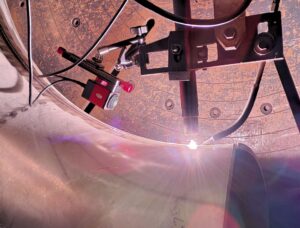Welding is a skill that requires precision, patience, and the right techniques to achieve strong and durable welds. However, many welders—both beginners and experienced professionals—can make common welding mistakes that compromise welding quality and lead to defects like slag inclusion, poor penetration, or weak joints. By understanding these weld problems and using advanced welding technology such as weld monitoring systems and welding cameras, you can significantly improve accuracy and efficiency. This guide covers the most common welding mistakes and practical ways to avoid them, ensuring a higher standard of weld inspection and defect-free results.
1. Incorrect Heat Settings
Using the wrong heat setting is one of the most frequent mistakes in MIG welding, TIG welding, and arc welding. If the heat is too low, you may get poor penetration, while excessive heat can cause warping or burn-through.
How to Avoid It:
- Always refer to the manufacturer’s recommendations for correct voltage and amperage settings.
- Use a welding camera or weld monitoring system to observe the weld pool in real time, ensuring proper penetration.
- Adjust heat settings based on material thickness—thicker materials require higher amperage, while thinner ones need lower settings to prevent distortion.
2. Poor Joint Preparation
Failing to clean and prepare the joint properly can lead to weld defects such as contamination, lack of fusion, and excessive porosity.
How to Avoid It:
- Remove any rust, oil, paint, or dirt from the metal surface before welding.
- Ensure a proper fit-up between the workpieces to avoid large gaps or misalignment.
- Use weld inspection techniques such as visual inspection or a welding quality check before starting.
3. Insufficient Shielding Gas Coverage
Shielding gas plays a crucial role in MIG welding, TIG welding, and plasma arc welding, protecting the weld from atmospheric contamination. Inadequate coverage can result in porosity and weak welds.
How to Avoid It:
- Use the correct shielding gas mixture based on the welding process (e.g., argon for TIG welding, CO₂ for MIG welding).
- Check for leaks in gas hoses and ensure the gas flow rate is properly adjusted.
- Utilize a welding camera manufacturer’s equipment to monitor the gas flow and prevent defects.
4. Improper Electrode Selection and Handling
Using the wrong electrode type or improperly handling it can affect weld penetration, bead appearance, and overall strength.
How to Avoid It:
- Match the electrode to the welding process (e.g., Tungsten Inert Gas (TIG) electrodes for precision welding).
- Store electrodes in a dry environment to prevent moisture absorption, which can lead to weld slag inclusion.
- Ensure proper polarity settings—some electrodes require DC+ while others use AC.
5. Slag Inclusion and Weld Spatter
Slag inclusion is a common issue in stick welding (SMAW) and flux-cored welding, where non-metallic material gets trapped in the weld. Excessive spatter, on the other hand, results in rough, uneven weld beads.
How to Avoid It:
- Use the correct electrode angle and maintain a consistent travel speed.
- Clean between passes when multi-pass welding to remove excess slag.
- Employ a weld monitoring system to detect slag issues in real time.
6. Poor Welding Technique and Positioning
Inconsistent movement, incorrect travel speed, and improper welding angles can lead to weak welds and lack of fusion.
How to Avoid It:
- Maintain a steady hand and use proper welding posture for control.
- Use the recommended travel speed—too fast leads to lack of fusion, while too slow can cause excessive build-up.
- Arc welding images and training materials can help improve technique and positioning.
7. Lack of Weld Inspection and Quality Control
Skipping weld inspection can result in unnoticed defects, leading to structural failures or costly repairs.
How to Avoid It:
- Perform welding visual inspection immediately after completing the weld.
- Use advanced weld inspection techniques such as X-rays or ultrasonic testing for critical applications.
- Incorporate a weld monitoring camera to capture detailed footage of the welding process, allowing for real-time analysis.
8. Ignoring Welding Safety Precautions
Many welders overlook safety measures, increasing the risk of burns, electric shock, and exposure to toxic fumes.
How to Avoid It:
- Always wear flame-resistant protective clothing and an auto-darkening welding helmet.
- Work in a well-ventilated area or use fume extractors when welding indoors.
- Follow proper electrical grounding procedures to prevent shock hazards.
Conclusion: Perfecting Your Welding Skills with Technology
Avoiding these common welding mistakes is key to improving welding quality and ensuring strong, defect-free welds. By using modern welding technology such as welding cameras and weld monitoring systems, you can enhance precision, reduce errors, and streamline quality control.
Need better weld inspection solutions? Explore Mecaweld’s welding cameras to improve efficiency, accuracy, and defect detection in your welding processes.
Contact us today to learn how real-time weld monitoring can optimize shipbuilding and repair operations!



